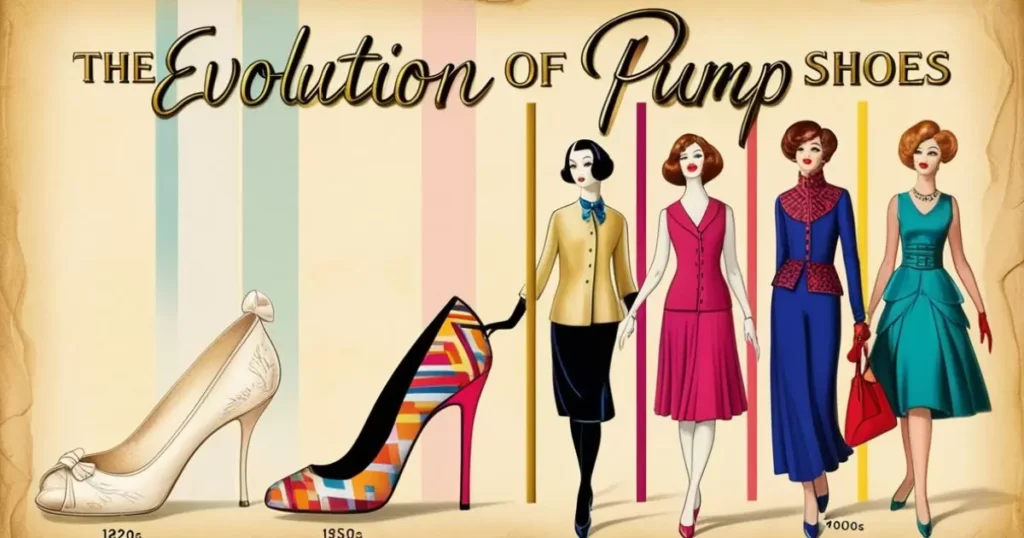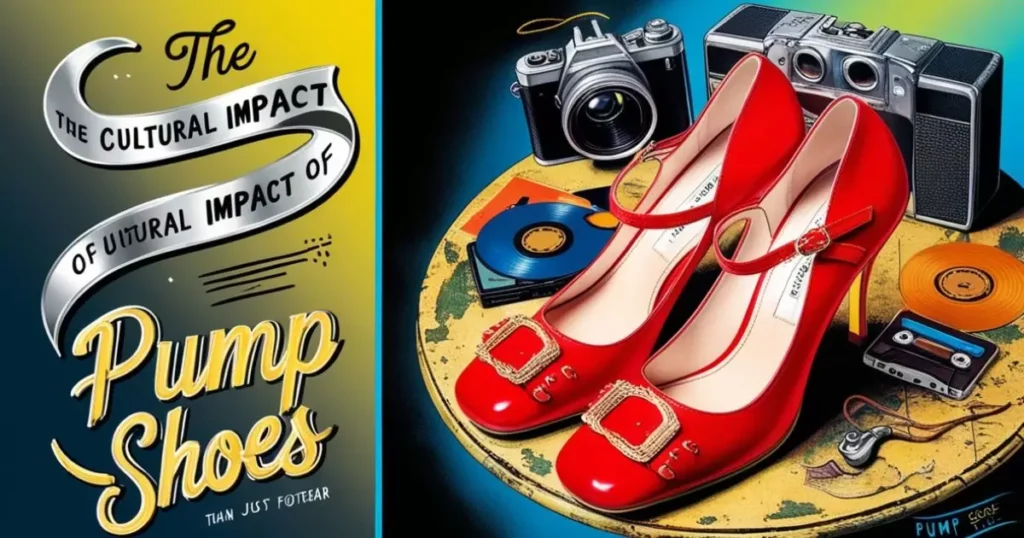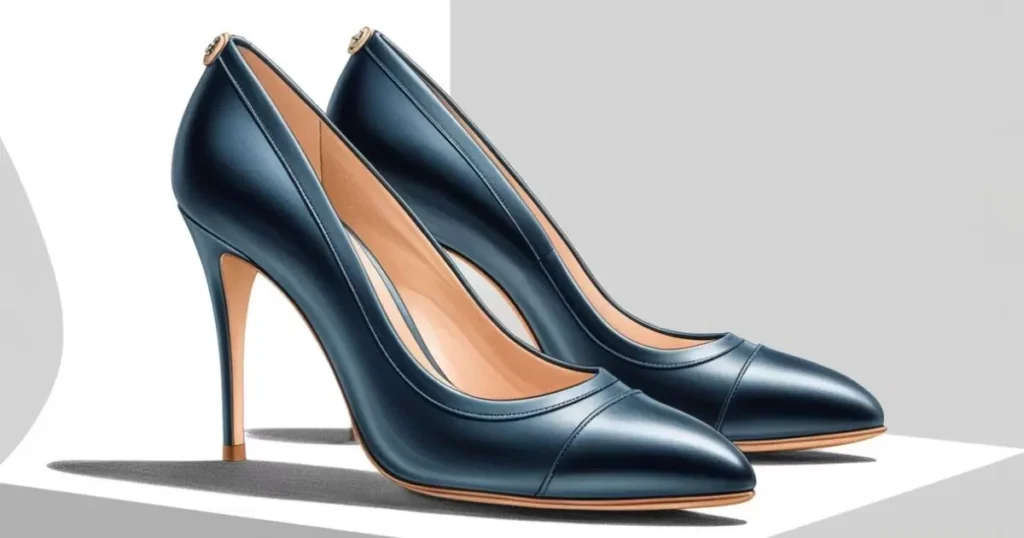Pump shoes have graced the feet of fashionistas, professionals, and royalty for centuries. These versatile and elegant shoes continue to captivate wearers with their timeless appeal and ability to elevate any outfit. In this comprehensive guide, we’ll dive deep into the world of pump shoes, exploring their rich history, diverse styles, and enduring impact on fashion and culture.
Introduction: Defining the Pump Shoe
Pump shoes, often simply called “pumps,” are a classic footwear style characterized by their sleek, slip-on design and absence of laces or fasteners. Typically featuring a closed toe and low-cut front, pumps expose the top of the foot and come in various heel heights. But what sets pumps apart from other shoe styles, and why have they remained a wardrobe staple for so long?
Key Features of Pump Shoes:
- Slip-on design
- Closed toe (with some variations)
- Low-cut front
- Heel height ranging from 1 inch to 4+ inches
- Streamlined silhouette
Pumps offer a perfect blend of sophistication and versatility. They can effortlessly transition from day to night, complementing both professional attire and evening wear. This adaptability, combined with their elegant silhouette, has cemented pumps as an essential footwear choice for many.
The Evolution of Pump Shoes: A Walk Through Time

The history of pump shoes is as fascinating as the shoes themselves, spanning centuries and continents. Let’s take a journey through time to understand how this iconic footwear style evolved.
Ancient Origins
Believe it or not, the concept of elevated footwear dates back to ancient Egypt. Wealthy Egyptians wore sandals with slightly raised heels, which can be considered early precursors to modern pumps.
16th-Century European Court Shoes
The true ancestors of today’s pumps emerged in 16th-century Europe. Courtiers wore heeled shoes to appear taller and more commanding. These early pumps were often adorned with intricate embroidery and jewels, signifying the wearer’s status.
20th-Century Fashion Revolution
The 20th century saw pumps evolve into the form we recognize today. In the 1920s, flapper girls embraced low-heeled pumps for dancing. By the 1950s, stiletto heels had taken the fashion world by storm, epitomized by icons like Marilyn Monroe.
“Give a girl the right shoes, and she can conquer the world.” – Marilyn Monroe
Modern Interpretations
Today’s pumps come in an astounding array of styles, from classic leather stilettos to avant-garde designs pushing the boundaries of fashion and function. Designers continually reinvent pumps, experimenting with materials, heel shapes, and embellishments.
Anatomy of a Pump: Breaking Down the Design
Understanding the key components of a pump shoe helps appreciate its design and functionality. Let’s dissect the anatomy of a classic pump:
- Vamp: The front part of the shoe that covers the toes and top of the foot
- Toe Box: The area that encases the toes
- Throat: The opening where the foot enters the shoe
- Sole: The bottom part of the shoe that contacts the ground
- Insole: The inner part of the sole where the foot rests
- Outsole: The outer part of the sole that touches the ground
- Heel: The raised back part of the shoe
- Heel Cap: The bottom tip of the heel that contacts the ground
- Topline: The upper edge of the shoe opening
Pumps differ from other shoe styles in their simplicity and lack of additional features like straps, laces, or buckles. This clean design contributes to their versatility and timeless appeal.
Pump Varieties: Beyond the Basics
While the classic pump remains a favorite, numerous variations have emerged over the years. Let’s explore some popular pump styles:
Classic Stiletto Pumps
The epitome of elegance, stiletto pumps feature a thin, high heel typically measuring 3-4 inches or more. They elongate the leg and add a touch of glamour to any outfit.
Kitten Heel Pumps
For those seeking comfort without sacrificing style, kitten heel pumps offer a lower heel height of 1.5-2 inches. They’re perfect for all-day wear and provide a sophisticated look.
Block Heel Pumps
Combining stability with style, block heel pumps feature a wider, chunkier heel. They offer more support than stilettos and come in various heights.
Peep-Toe Pumps
These pumps feature a small opening at the toe, adding a flirty touch to the classic pump design. They’re popular for spring and summer wear.
Slingback Pumps
Slingbacks have a strap that wraps around the back of the heel, providing extra support and a unique look. They’re versatile enough for both casual and formal occasions.
Platform Pumps
By adding height to the front of the shoe, platform pumps create a dramatic look while often being more comfortable than traditional high heels.
Wedge Pumps
Wedge pumps feature a solid, wedge-shaped outsole that extends from heel to toe. They offer stability and comfort while still providing height.
Unconventional Designs
Innovative designers continue to push the boundaries with sculptural heels, unusual materials, and avant-garde shapes, creating pumps that are wearable works of art.
Materials and Craftsmanship: The Building Blocks of Quality Pumps
The materials used in pump construction greatly influence their appearance, durability, and comfort. Let’s examine some common materials and their characteristics:
Traditional Materials
- Leather: Durable, breathable, and molds to the foot over time
- Suede: Soft, luxurious appearance but requires more care
- Patent Leather: Glossy finish, easy to clean but less breathable
Modern Synthetics and Eco-Friendly Options
- Faux Leather: Animal-friendly alternative with varying quality
- Recycled Plastics: Sustainable option gaining popularity
- Cork: Lightweight, eco-friendly material often used in soles
Luxury Materials
- Exotic Skins: Crocodile, ostrich, and snakeskin for high-end pumps
- High-End Fabrics: Silk, velvet, and brocade for special occasion pumps
The Art of Pump Construction
Crafting a quality pump involves multiple steps and requires skilled artisanship. Here’s a simplified overview of the process:
- Last Creation: A foot-shaped mold is created or selected
- Pattern Making: The shoe’s design is translated into pattern pieces
- Cutting: Materials are cut according to the pattern
- Stitching: The upper parts of the shoe are sewn together
- Lasting: The upper is stretched over the last and attached to the insole
- Sole Attachment: The outsole is attached to the upper
- Finishing: Final touches like heel attachment and polishing are completed
Finding Your Perfect Pair: A Buyer’s Guide

Selecting the right pair of pumps involves considering various factors to ensure comfort, style, and functionality. Here are key points to keep in mind:
Considering Foot Shape and Size
- Measure your feet regularly, as size can change over time
- Consider width as well as length
- Try shoes on later in the day when feet are slightly swollen
Heel Height and Comfort Trade-offs
| Heel Height | Comfort Level | Best For |
| 1-2 inches | High | All-day wear, office |
| 2-3 inches | Moderate | Dinner, events |
| 3+ inches | Low | Special occasions, short durations |
Occasion-Based Selection
- Office: Opt for closed-toe pumps with heel heights under 3 inches
- Casual outings: Consider wedges or block heels for comfort
- Formal events: Classic stilettos or embellished pumps shine
Color Psychology in Pump Choices
- Black: Timeless, versatile, professional
- Nude: Leg-lengthening, goes with everything
- Red: Bold, confident, attention-grabbing
- Metallic: Festive, eye-catching for special occasions
Breaking in New Pumps
- Wear them around the house with thick socks
- Use a shoe stretcher for tight spots
- Apply moleskin to areas prone to blisters
- Gradually increase wearing time
Styling Pump Shoes: From Workwear to Evening Glamour
Pumps are incredibly versatile, suitable for a wide range of outfits and occasions. Here are some styling tips:
Workplace Chic
- Pair black or nude pumps with tailored trousers and a crisp blouse
- Add a pop of color with bold pumps to liven up a neutral suit
- Choose block heels for comfort during long work days
Casual-Cool Looks
- Wear wedge pumps with jeans and a t-shirt for an elevated casual look
- Pair kitten heel pumps with a sundress for a feminine daytime outfit
- Try colorful pumps with monochrome outfits for a fun accent
Evening Elegance
- Classic stilettos complement cocktail dresses and formal gowns
- Embellished or metallic pumps add sparkle to simple evening wear
- Satin pumps offer a luxe touch for black-tie events
Unexpected Pairings
- Contrast feminine pumps with edgy leather jackets
- Wear pumps with cropped pants to showcase the shoes
- Mix patterns by pairing printed pumps with complementary prints in your outfit
Caring for Your Pumps: Maintenance Tips for Longevity
Proper care can significantly extend the life of your pump shoes. Follow these tips to keep your pumps looking their best:
Cleaning Techniques for Various Materials
- Leather: Wipe with a damp cloth and condition regularly
- Suede: Use a suede brush and protector spray
- Patent Leather: Clean with a soft cloth and mild soap solution
- Fabric: Spot clean with appropriate fabric cleaner
Professional Maintenance Tips
- Resole pumps when the soles show significant wear
- Replace heel tips before they wear down to the plastic
- Consider waterproofing treatments for leather pumps
Proper Storage Solutions
- Store pumps in a cool, dry place away from direct sunlight
- Use shoe trees to maintain shape
- Keep pumps in dust bags or boxes to prevent scratches
Extending the Life of Your Favorite Pairs
- Rotate your shoes to prevent overuse
- Allow shoes to air out between wears
- Use heel caps to protect heels when walking on uneven surfaces
The Cultural Impact of Pump Shoes: More Than Just Footwear

Pump shoes have left an indelible mark on popular culture, symbolizing femininity, power, and style.
Pumps in Film and Television
From Cinderella’s glass slipper to Carrie Bradshaw’s Manolo Blahniks in “Sex and the City,” pumps have played starring roles in many productions.
Celebrity Pump Moments
- Marilyn Monroe’s white pumps in “The Seven Year Itch”
- Princess Diana’s “revenge dress” paired with black pumps
- Michelle Obama’s colorful pump choices during her time as First Lady
Gender Norms and Pumps
While traditionally associated with women’s fashion, pumps have also been worn by men throughout history, challenging gender norms in footwear.
Pumps as Power Symbols
In the corporate world, high heels have often been seen as a symbol of female empowerment and professionalism, though this view is evolving with changing workplace norms.
Innovations in Pump Design: The Future of Fashionable Footwear
As technology and sustainability become increasingly important in fashion, pump design continues to evolve.
Technology for Improved Comfort
- Memory foam insoles for cushioning
- 3D-printed custom fits
- Shock-absorbing materials in heels
Sustainable Manufacturing Practices
- Use of recycled and upcycled materials
- Water-based adhesives and eco-friendly dyes
- Biodegradable components
Customization and Bespoke Options
- Online platforms offering made-to-order pumps
- Interchangeable heels for versatility
- Personalized embellishments and monograms
Future Trends in Pump Shoes
- Smart pumps with built-in sensors for posture correction
- Self-adjusting heels for optimal comfort
- Augmented reality for virtual try-ons
Conclusion: The Enduring Appeal of Pump Shoes
Pump shoes have come a long way from their origins in ancient courts to become a ubiquitous presence in modern wardrobes. Their enduring popularity stems from an unmatched combination of elegance, versatility, and the power to transform an outfit.
As we look to the future, pumps continue to evolve, incorporating new technologies and sustainable practices while maintaining their classic appeal. Whether you’re a pump aficionado or new to the world of heeled shoes, there’s no denying the impact and allure of this timeless footwear classic.
From the boardroom to the red carpet, pump shoes remain a symbol of style, confidence, and sophistication. As fashion trends come and go, the pump stands tall as a true icon of footwear design, ready to elevate any look and empower the wearer with every step.
Frequently Asked Questions
1. Q: What defines a pump shoe?
A: A pump shoe is a slip-on style footwear with a closed toe, low-cut front, and typically a heel. It lacks straps, laces, or other fasteners.
2. Q: Are pump shoes comfortable for all-day wear?
A: Comfort depends on the heel height and fit. Lower heels (1-2 inches) are generally more comfortable for extended periods. Proper sizing and cushioning also play crucial roles in comfort.
3. Q: Can pump shoes be worn casually?
A: Yes, pumps can be styled casually. Lower heels, wedges, or pumps in relaxed materials like canvas can easily complement casual outfits.
4. Q: How do I choose the right size pump shoe?
A: Measure your feet late in the day when they’re slightly swollen. Ensure there’s about a thumb’s width of space between your longest toe and the shoe’s tip. Consider both length and width for the best fit.
5. Q: What’s the difference between pumps and high heels?
A: All pumps are high heels, but not all high heels are pumps. Pumps specifically refer to shoes without straps or closures, while “high heels” is a broader term that includes various styles with elevated heels.

An author is a creator of written content, producing works ranging from books and articles to blog posts and essays. They use their creativity, knowledge, and research to inform, entertain, or persuade readers. Authors often have a unique voice and perspective, contributing significantly to literature and various media.

